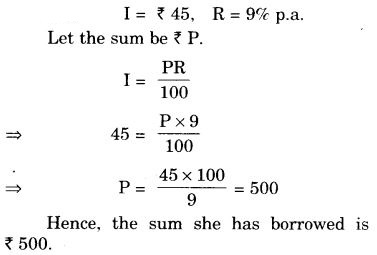GetStudySolution
Getstudysolution is an online educational platform that allows students to access quality educational services and study materials at no cost.
NCERT Solutions for class 7 Maths chapter 8 – Comparing Quantities
Back Exercise
Exercise 8.1
Question 1.
Find the ratio of:
(a) ₹ 5 to 50 paise
(b) 15 kg to 210 g
(c) 9 m to 27 cm
(d) 30 days to 36 hour
Solution:
(a) ₹ 5 : 50 paise
= ₹ 5 : 50 paise
= 5 × 100 paise : 50 paise
= 500 paise : 50 paise
= 10 : 1.
(b) 15 kg to 210g
= 15 kg : 210g
= 15 × 1000 g : 210g
= 15000 g : 210g = 500:7.
(c) 9 m to 27 cm
= 9m : 27 cm = 9 × 100 cm : 27 cm
= 900 cm : 27 cm
900 : 27 = 100 : 3.
(d) 30 days to 36 hours
= 30 days : 36 hours
30 × 24 hours : 36 hours
= 720 hours : 36 hours
= 720 : 36 = 20 : 1.
Question 2.
In a computer lab, there are 3 computers for every 6 students. How many computers will be needed for 24 students?
Solution:
Let x computers be needed for 24 students.
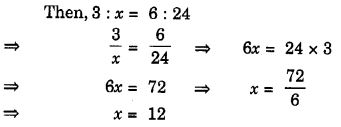
Hence, 12 computers will be needed for
24 students.
Aliter:
In a computer lab,
Every 6 students need 3 computers.
∴ Every 1 student needs
∴ Every 24 students need
Question 3.
Population of Rajasthan = 570 lakhs
and population of UP = 1660 lakhs.
Area of Rajasthan =3 lakh km2
and area of UP = 2 lakh km2.
(i) How many people are there per km2 in both these States?
(ii) Which State is less populated?
Solution:
(i) Number of people per sq. km. in Rajasthan state

(ii) The Rajasthan State is less populated.
Exercise 8.2
Question 1.
Convert the given fractional numbers to per cents.
(a)
(b)
(c)
(d)
Solution:
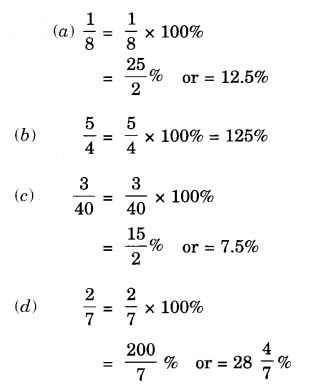
Question 2.
Convert the given decimal fractions to per cents.
(a) 0.65
(b) 2.1
(c) 0.02
(d) 12.35
Solution:
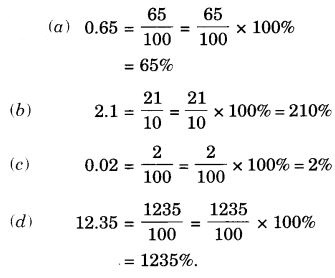
Question 3.
Estimate what part of the figures is coloured and hence find the percent which is coloured.
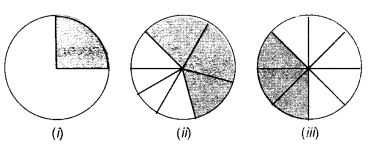
Solution:
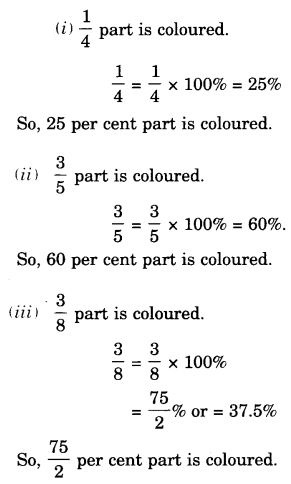
Question 4.
Find:
(a) 15% of 250
(b) 1% of 1 hour
(c) 20% of ₹ 2500
(d) 75% of 1 kg.
Solution:

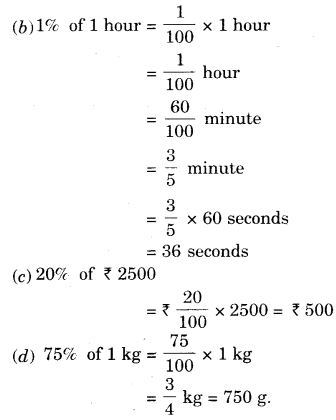
Question 5.
Find the whole quantity if
(a) 5% of it is 600.
(b) 12% of it is ₹ 1080.
(c) 40% of it is 500 km.
(d) 70% of it is 14 minutes.
(e) 8% of it is 40 liters.
Solution:
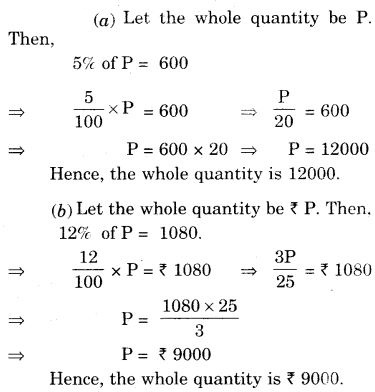
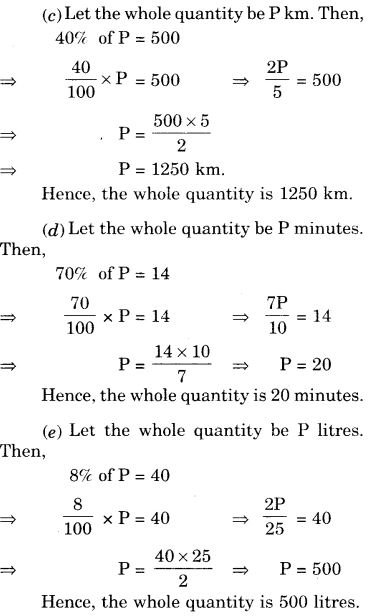
Question 6.
Convert given percents to decimal fractions and also to fractions in the simplest forms.
(a) 25%
(b) 150%
(c) 20%
(d) 5%
Solution:
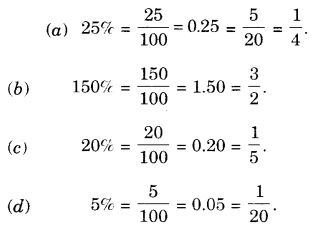
Question 7.
In a city, 30% are females, 40% are males, and the remaining are children. What percent are children?
Solution:
[100% (30% + 40%)] are children
⇒ [100% – 70% ] are children
⇒ 30% are children.
Question 8.
Out of 15,000 voters in a constituency, 60% voted. Find the percentage of voters who did not vote. Can you now find how many actually did not vote?
Solution:
Percentage of voters who voted = 60%
Percentage of voters who did not vote = (100 – 60)% = 40%
Total number of voters = 15000
Number of voters who did not vote = 40% of 15000
= (
= 6000
Question 9.
Meeta saves ₹ 400 from her salary. If this is 10% of her salary. What is her salary?
Solution:
Let her salary be ₹ P. Then, 10% of P = 400
⇒
⇒
⇒ P = 400 × 10
⇒ P = 4000
Hence, her salary is ₹ 4000.
Question 10.
A local cricket team played 20 matches in one season. It won 25% of them. How many matches did they win?
Solution:
Out of 100, 25% matches are won. Then, out of 20, the number of matches that the team won
=
=
= 5
Exercise 8.3
Question 1.
Tell what is the profit or loss in the following transactions. Also find profit percent or loss per cent in each case.
(a) Gardening shears bought for ₹ 250 and sold for ₹ 325.
(b) A refrigerater bought for ₹ 12,000 and sold at ₹ 13,500.
(c) Acupboard bought for ₹ 2,500 and sold at ₹ 3,000.
(d) A skirt bought for ₹ 250 and sold at ₹ 150.
Solution:
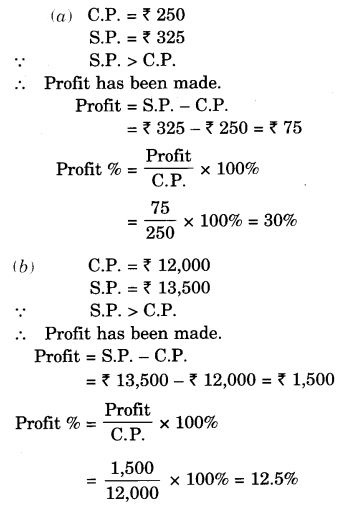
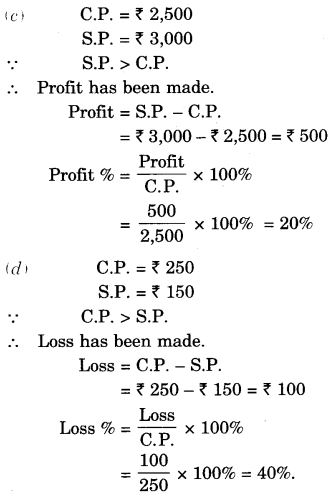
Question 2.
Convert each part of the ratio to percentage
(a) 3 : 1
(b) 2 : 3 : 5
(c) 1 : 4
(d) 1 : 2 : 5
Solution:

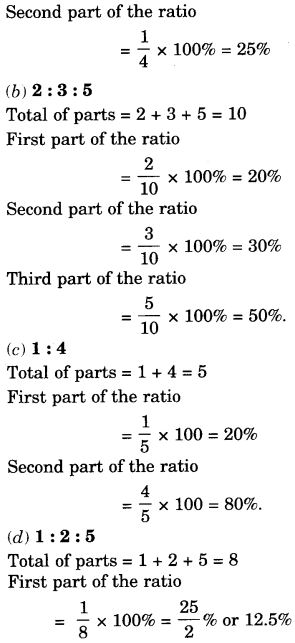
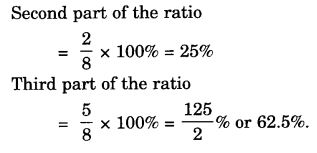
Question 3.
The population of a city decreased from 25,000 to 24,500. Find the percentage decrease.
Solution:
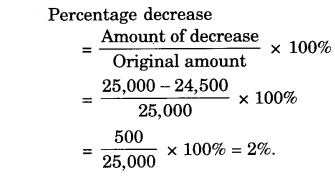
Question 4.
Arun bought a car for ₹ 3,50,000. The next year, the price went upto ₹ 3,70,000. What was the percentage of the price increase?
Solution:
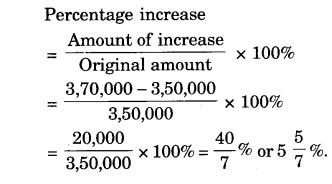
Question 5.
1 buy a T.V. for ₹ 10,000 and sell it at a profit of 20%. How much money do I get for it?
Solution:
C.P. = ₹ 10,000
Profit = 20% of C.P.
= 20% of ₹ 10,000
= ₹
∴ S.P. = C.P. + Profit
= ₹ 10,000 + ₹ 2,000 = ₹ 12,000
Hence, I get ₹ 12,000 for it.
Question 6.
Juki sells a washing machine for ₹ 13,500. She loses 20% in the bargain. What was the price at which she brought it?
Solution:

Question 7.
(i) Chalk contains calcium, carbon, and oxygen in the ratio of 10 : 3 : 12. Find the percentage of carbon in chalk.
(ii) If in a stick of chalk, carbon is 3 g, what is the weight of the chalk stick?
Solution:

Question 8.
Amina buys a book for ₹ 275 and sells it at a loss of 15%. How much does she sell it for?
Solution:
C.P. = ₹ 275
Loss = 15% of C.P =
=
= ₹ 41.25
S.P. = C.P. – Loss = 275 – 41.25 = ₹ 233.75
hence, she se11 it for ₹ 233.75.
Question 9.
Find the amount to be paid at the end of 3 years in each case:
(a) Principal = ₹ 1,200 at 12% p.a.
(b) Principal = ₹ 7,500 aat 5% p.a.
Solution:
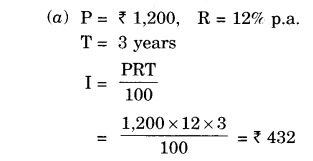

Question 10.
What rate gives ₹ 280 as interest on a sum of ₹ 56,000 in 2 years?
Solution:
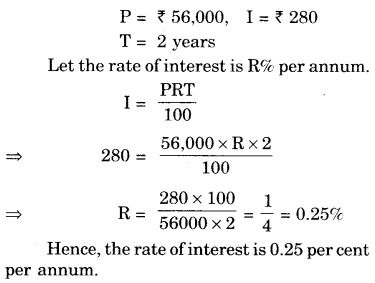
Question 11.
If Meena gives an interest of ₹ 45 for one year at 9% rate p.a. What is the sum she has borrowed?
Solution:
